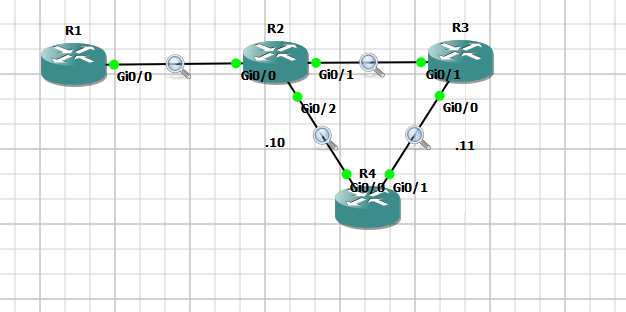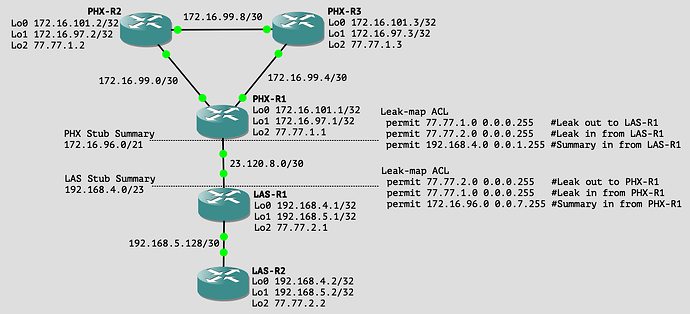This topic is to discuss the following lesson:
Hi.
I have a question.
When turn R2 into a stub router, neighbor router of R2 don’t send advertise routes except connected and summary?
After I turn R2 into a stub router, I looked R2 Routing table.
R2 have entry about R3 L0 and L1 route.
Is this correct?
R2#sh ip route eigrp | be Gateway
Gateway of last resort is not set
3.0.0.0/32 is subnetted, 1 subnets
D 3.3.3.3 [90/130816] via 192.168.23.3, 00:07:35, GigabitEthernet2
33.0.0.0/32 is subnetted, 1 subnets
D 33.33.33.33 [90/130816] via 192.168.23.3, 00:07:35, GigabitEthernet2
R2#
R2#sh run | sec router
router eigrp 1
network 192.168.12.0
network 192.168.23.0
eigrp stub connected summary leak-map R3_L0_LEAK
R2#
Yoichi
Hello Yoichi
When R2 is configured as a stub router, this means that R2 only advertises connected and summary routes. This configuration does not affect the behavior of R3. So R3 still sends out its entries for L0 and L1, and R2 receives them. However, R2 will only advertise connected and summary routes to R1. This is the behavior of the stub feature for EIGRP.
I hope this has been helpful!
Laz
Hello Laz
Thank you so much!!
I could understand well.
Yoichi
The network 1.1.1.1/32 is on R1
I was investigating split horizon and EIGRP and I noticed that if router R3 is a stub it will not send back infinite routes through the interface(Gi0/1) that it learned the route(1.1.1.1) from. It will also not advertise the downstream route either to R4 through Gi0/0. I noticed this because show ip eigrp topology all-links was not showing a non successor through gi0/1. Also furthermore after shutting down the backup link Gi0/0(to R2) there is no longer a route to destnation 1.1.1.1(through gi0/1). if you setup R3 as a stub, it appears that leak maps solve all of those problems. I haven’t really seen this in the documentation. There is a post online where a network engineer ran into unreachable networks down stream from a stub.
The answer to the problem was my clue.
Hello Justin
Thanks for sharing your experience and the results of your investigations of the split horizon and stub features of EIGRP. This behavior that you observed in the R3 router is indeed based on how EIGRP operates. The behavior centers on the fact that R3 is configured as a stub even though it has more than one connection to the rest of the EIGRP topology.
The term “stub” typically denotes an endpoint or a router at the edge, and in the common EIGRP use case, it’s often a router with a single connection to the rest of the network. Such routers are ideal candidates for the stub feature because they don’t need to handle or propagate EIGRP queries. Their sole path into the EIGRP domain is via that one connection.
However, the EIGRP stub feature, in its pure technical definition, does not prohibit a router from having multiple connections. It’s more about the behavior of the router in the EIGRP topology than its connection count, and this is the behavior you observed. When you make an EIGRP router a stub, it signals its neighbors to not send it queries.
By default, a stub router will only advertise connected and summary routes. As a result, a stub router will not advertise routes it has learned from other EIGRP neighbors. This means the router upstream will not have knowledge of any downstream routes beyond the stub router.
You are indeed correct that stub leak maps do resolve these issues. Personally, the reason I believe that you haven’t seen this documented anywhere is the fact that a router with multiple connections to an EIGRP topology is not typically configured as a stub, and thus its behavior can be unexpected and not immediately understandable.
I hope this has been helpful!
Laz
Ah, maybe that explains the question I came here to ask!
I was doing bidirectional stub summarization with leak maps. I saw that PHX-R1 had the summary route and leaked routes from LAS-R1, and vice versa, but the routers behind them (PHX-R2, PHX-R3, LAS-R2) did not get those routes. Once I added ACEs to the leak-map ACLs permitting inbound summary and leaked routes, all the information propagated as desired.
So if I understand it correctly, since LAS-R1 was also a stub, it wasn’t relaying the summary/leaked routes it received from PHX-R1 (and same for LAS-R1 to PHX-R1)?
Hello Shane
Yes, that’s exactly it. Even though the advertisement from the EIGRP neighbor was a summary/leaked route, it still adheres to this rule of not advertising any routes that were received from other EIGRP routers. So the reason you weren’t seeing those routes is indeed the fact that an EIGRP stub router will only advertise connected routes and summary routes.
Thanks for sharing that with us and giving another good example of how this feature works.
I hope this has been helpful!
Laz

